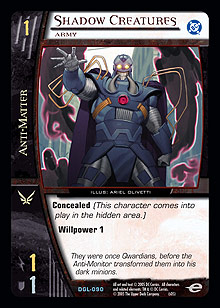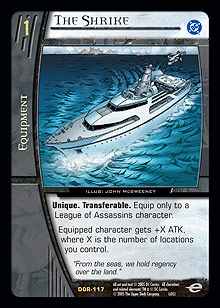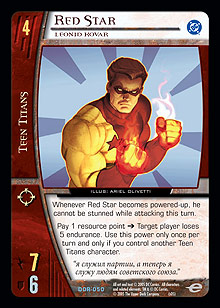
I’ve mentioned in the past that encouraging off-curve strategies has been a priority for us in recent sets. In the early tournament scene, the vast majority of competitive decks attempted to play the highest cost character each and every turn. The few notable exceptions were geared toward taking advantage of a particularly powerful card in the deck rather than playing off-curve as a general rule. For example, the Titans might play off-curve on decisive turns to take advantage of Roy Harper ◊ Arsenal, Sharpshooter. Doom decks might go off-curve to play Boris, and The New Brotherhood decks might play off-curve if they draw enough copies of the deck’s namesake. Both Roy and The New Brotherhood reward the sheer number of characters a player has in play.
 The majority of other off-curve decks we’ve seen were also trying to capitalize on cards that counted characters in play or rewarded all characters in play. For example, Sentinel Mark IV, Dr. Light, Arthur Light, Batman, The Dark Knight, and The Blackbird were all cornerstones of decks that approached the tournament spotlight. The use of 1-cost army characters in such decks wasn’t all that infrequent. The trend continued even into this PCQ season with the likes of Shadow Creatures and Soldiers of the New Genesis. This reliance on army characters isn’t surprising since they get around a couple of interrelated problems of off-curve strategies—you don’t have to worry about character uniqueness, and once you’ve found a suitable army character for your strategy, you have as many playable, low cost character cards for your deck as you need.
The majority of other off-curve decks we’ve seen were also trying to capitalize on cards that counted characters in play or rewarded all characters in play. For example, Sentinel Mark IV, Dr. Light, Arthur Light, Batman, The Dark Knight, and The Blackbird were all cornerstones of decks that approached the tournament spotlight. The use of 1-cost army characters in such decks wasn’t all that infrequent. The trend continued even into this PCQ season with the likes of Shadow Creatures and Soldiers of the New Genesis. This reliance on army characters isn’t surprising since they get around a couple of interrelated problems of off-curve strategies—you don’t have to worry about character uniqueness, and once you’ve found a suitable army character for your strategy, you have as many playable, low cost character cards for your deck as you need.
When players can’t take advantage of army characters, they often need to branch out to other teams to get an adequate number of characters for their swarming strategy. It doesn’t hurt when a card that teams them up further fosters an off-curve strategy. We’ve seen this with Honor Among Thieves, and I won’t be the least bit surprised to see it again with Faces of Evil. Besides incorporating Dr. Light, Master of Holograms into a largely Green Lantern–based group of characters, Green Lantern/Emerald Enemies (GLEE) decks had to look outside the team for the pool of characters they needed. Meanwhile, decks that rely heavily on team-stamped cards, like The New Brotherhood decks, diversify their choice of characters (because of uniqueness issues) to the point that they incorporate character cards you would not otherwise expect to see in a rush strategy.
Our final concern with off-curve strategies is in having them function in Golden Age. The last two Modern Ages formats have illustrated quite well that low cost characters can more than hold their own, even in a world of exponentially increasing ATK and DEF values compared to character cost. In fact, it has become apparent that swarm strategies might be too strong without certain checks. As a result, we tried to fine tune the cards for our Modern Age environments to keep a healthy balance between curve and off-curve strategies. Cards like Hawkeye, Clinton Barton and Avengers Disassembled reflect those efforts. Meanwhile, we keep a close eye on the number of cards that punish lower cost characters. And what of Golden Age? Short of making more cards like Fizzle or A Child Named Valeria, what are we to do?
 There’s no short answer here, but we are trying to provide off-curve strategies with more answers to problematic cards like Flame Trap! by making cards like Paul Ebersol ◊ Fixer. We’re also trying to provide ways for theses deck to overcome consistency and uniqueness issues with additional character search effects. Even with Overload removed from the equation, off-curve decks are still fighting an uphill battle; they can be challenged in a variety of ways from cards like Total Anarchy, Reign of Terror, Micro-Sentinels, Terra, and Mikado and Mosha. Nevertheless, we will continue to give these decks tools to fight this battle. It will also be interesting to see what will become of the influx of new, small-cost X-Men and Brotherhood characters coming a couple of sets down the road.
There’s no short answer here, but we are trying to provide off-curve strategies with more answers to problematic cards like Flame Trap! by making cards like Paul Ebersol ◊ Fixer. We’re also trying to provide ways for theses deck to overcome consistency and uniqueness issues with additional character search effects. Even with Overload removed from the equation, off-curve decks are still fighting an uphill battle; they can be challenged in a variety of ways from cards like Total Anarchy, Reign of Terror, Micro-Sentinels, Terra, and Mikado and Mosha. Nevertheless, we will continue to give these decks tools to fight this battle. It will also be interesting to see what will become of the influx of new, small-cost X-Men and Brotherhood characters coming a couple of sets down the road.
When we were deciding on the areas in which the teams in the Avengers set would excel, we wanted to include mechanics that would reward off-curve decks in new ways. How might we get players to play off-curve for new reasons?
Improvement during Game Progression
 Whenever we look for ways to make off-curve strategies more viable, I always jump on the idea of having characters that improve with time. I believe it was all the way back in Marvel Origins that I tried to get an equipment made that would give an ATK bonus dependent on the number of resources you controlled. This became the mythical “Growing Sword” of in-house R&D lingo. An approximation of this card was created with The Shrike. Taking on a similar role was Kyle Abbot, Wolf in Man’s Clothing. While a perfect play balance may not have been reached with these cards, I was very happy to see them made. I can only assume that later cards like Hector Hammond were the designers’ means of appeasing my nagging for such cards.
Whenever we look for ways to make off-curve strategies more viable, I always jump on the idea of having characters that improve with time. I believe it was all the way back in Marvel Origins that I tried to get an equipment made that would give an ATK bonus dependent on the number of resources you controlled. This became the mythical “Growing Sword” of in-house R&D lingo. An approximation of this card was created with The Shrike. Taking on a similar role was Kyle Abbot, Wolf in Man’s Clothing. While a perfect play balance may not have been reached with these cards, I was very happy to see them made. I can only assume that later cards like Hector Hammond were the designers’ means of appeasing my nagging for such cards.
In the Avengers set, I finally convinced Mike Hummel to use this idea as a major theme. Why would your deck plan on playing two 3-cost 5 ATK/4 DEF characters when you could play a 6-cost 13 ATK/12 DEF character instead? It would be hard to justify the two-character scenario as your plan, especially when factoring in the need to have two cards in hand totaling a specific cost (and neither having the same name as a character in play) rather than needing a single card. While I’ve discussed some other cards (like The New Brotherhood) that would make this desirable, I was hoping we could create cards that gave you self-contained reasons to do so. What if your 3-drop characters were each 9 ATK/7 DEF on turn 6? That should make the decision much more interesting.
The end result of this plan was the creation of many characters that were better at later stages of the game. That theme is concentrated in the Thunderbolts team, but it can also be found in characters like Shape and in more subtle ways on characters like Melter. These characters might not do much for you in the early game, but they can be spectacular later on.
Some of the “growing” characters differ in that they don’t have the same splash value when played late in the game. They have to pay their dues while actually grueling it out on the board. This is reflected in characters like Erik Josten ◊ Atlas, Kosmos Convict. These cards reward off-curve deckbuilding in a distinct fashion—they allow players to include small characters in their decks and feel that they are rewarded for preserving those characters. This is in contrast to some small characters who, by later turns of the game, can actually feel like a liability to have on your side. We felt that these growing characters would create more excitement in the early game because of the importance of keeping them around. As a result, players might re-evaluate whether or not to use their plot twists early in the game. To reinforce this theme in the Thunderbolts, the team was given a number of ways to protect its characters early in the game in the hope that they might shine later.
Resource Point Spending
 Spending resource points on payment powers isn’t novel to this set. Among other familiar teams, the Teen Titans have made good use of this strategy on cards such as Red Star and Optitron. And now that the Masters of Evil are around, the same may soon hold true for Jericho.
Spending resource points on payment powers isn’t novel to this set. Among other familiar teams, the Teen Titans have made good use of this strategy on cards such as Red Star and Optitron. And now that the Masters of Evil are around, the same may soon hold true for Jericho.
One of the primary reasons we ventured into resource point spending in this set was to help off-curve strategies. In a certain sense, this must hold true by definition. If you are using any resource points for non-recruit costs, you won’t be playing the highest cost character possible. As it turns out, though, we made a few Masters of Evil cards (including Erik Josten ◊ Goliath, Growing Menace; Titania. Vengeful Vixen; Ultron ◊ Ultron 5, Ultimate Evil; and Unfair Advantage) that allow you to max out your character drop and still use resource points for other purposes. These cards were added into the set to ensure that players were able to make significant use of the abundance of payment powers on the team, especially in the context of on-curve builds.
Ignoring the above subset of cards for the moment, we had specific goals in mind for non-recruitment resource point spending in this set. The first of these goals was to help swarm decks. In our experience, swarm decks reach a point in the game where they are running low on cards. At that point in the game and with a poor topdeck on a given turn, they might, for example, only have a 2- and 3-cost character in play on turn 6. Or worse, they might only have a 2-cost character. On a normal team, that player wouldn’t maximize his or her use of resource points. Since resource points are one of the main means of costing in our game, that player would be at a distinct disadvantage for not using those resource points that turn. However, if enough characters on the team had payment powers using resource points, a player could still fully utilize the resource system even without having drawn a character to play.
Of course, we also hoped these powers would help any time you didn’t have the character you “wanted” to play on a given turn and were forced to underdrop. We designed the team such that a player would intentionally underdrop at various points in the curve to take advantage of cards, like Hero’s Demise or Mystic Summons, that required you to control two characters of the same cost. Finally, we took things to the extreme by hoping that players might forgo playing a character at all under certain circumstances. Both Thunderball and the characters using large sums of resource points (such as Shocker, Vibro-Shock Villain, Whirlwind, and Enchantress) were designed with this goal in mind.
I’ll leave it at that for this week. I’ll be back next time to take a look at the most recent upstart in Golden Age, Kang, and how we had to deal with a character having eleven non-unique versions of himself.
Comments welcome at DHumpherys@metagame.com.